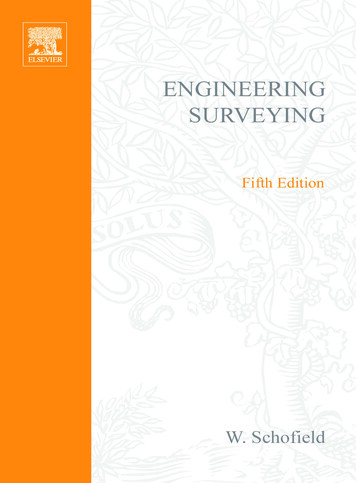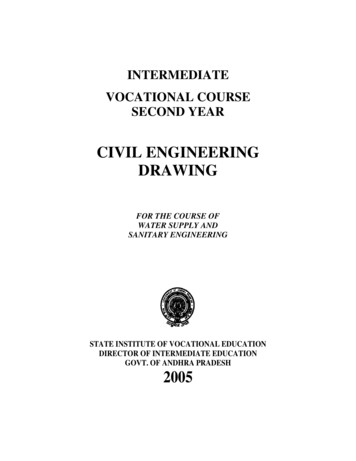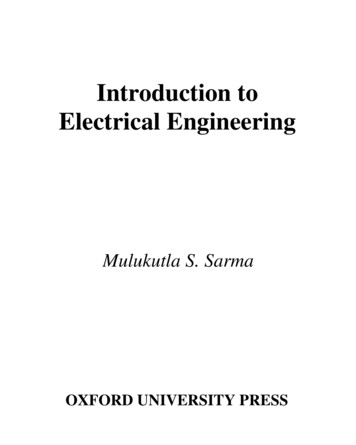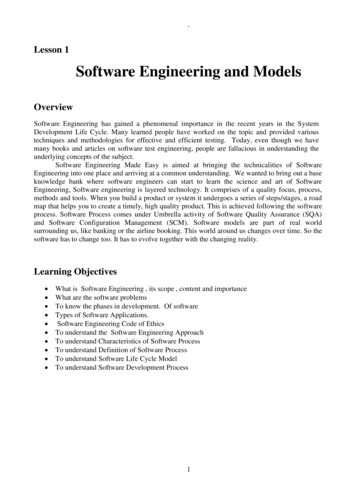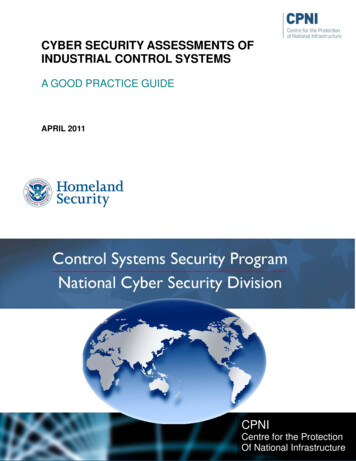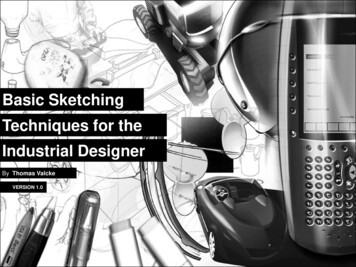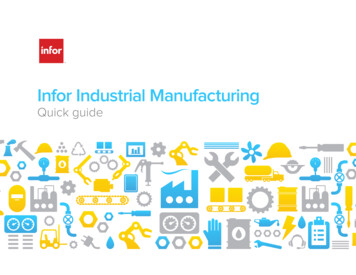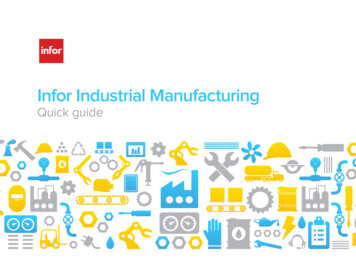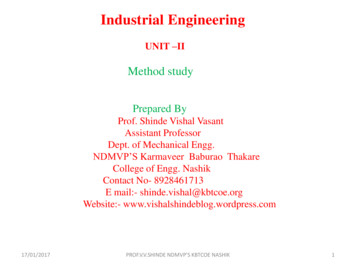
Transcription
Industrial EngineeringUNIT –IIMethod studyPrepared ByProf. Shinde Vishal VasantAssistant ProfessorDept. of Mechanical Engg.NDMVP’S Karmaveer Baburao ThakareCollege of Engg. NashikContact No- 8928461713E mail:- shinde.vishal@kbtcoe.orgWebsite:- .V.SHINDE NDMVP'S KBTCOE NASHIK1
Work Study The systematic examination of the method ofcarrying on activities so as to improve theeffective use of resources and to set up standardsof performance for the activities being carried out.17/01/2017PROF.V.V.SHINDE NDMVP'S KBTCOE NASHIK2
It is a generic term for those techniques, method studyand work measurement which are used in theexamination of human work in all its context. Andwhich lead systematically to the investigation of all thefactors which affect the efficiency and economy of thesituation being reviewed, in order to effectimprovementOR It is that body of knowledge concerned with theanalysis of the work methods and the equipment usedin performing a job, the design of an optimum workmethod and the standardization of proposed workmethods.17/01/2017PROF.V.V.SHINDE NDMVP'S KBTCOE NASHIK3
Work Study Work study has contributed immeasurably to thesearch for better method, and the effective utilizationof this management tool has helped in theaccomplishment of higher productivity. Work study is a management tool to achieve uring tangible products or offering servicesto its customers.17/01/2017PROF.V.V.SHINDE NDMVP'S KBTCOE NASHIK4
Work Study Method study It is the systematic recording & critical examinationof existing and proposed ways of doing work, as ameans of developing and applying easier and moreeffective methods and reducing cost Work measurement / Time study It is the application of techniques designed toestablish the time for a qualified worker to carry outa specified job at a defined level of performance17/01/2017PROF.V.V.SHINDE NDMVP'S KBTCOE NASHIK5
Objectives To analyze the present method of doing a job,systematically in order to develop a new andbetter method To measure the work content of a job bymeasuring the time required to do the job for aqualified worker and hence to establish standardtime. To increase the productivity by ensuring the bestpossible use of human, machine and materialresources and to achieve best quality product/service at minimum possible cost To improve operational efficiency17/01/2017PROF.V.V.SHINDE NDMVP'S KBTCOE NASHIK6
Benefits of work study Increased productivity and operational efficiencyReduced manufacturing costsImproved work place layoutBetter manpower planning and capacity planningFair wages to employeesBetter working conditions to employeesImproved work flowReduced material handling costs17/01/2017PROF.V.V.SHINDE NDMVP'S KBTCOE NASHIK7
Benefits of work study Provides a standard of performance to measurelabour efficiency Better industrial relations and employeemorale Basis for sound incentive scheme Provides better job satisfaction to employees17/01/2017PROF.V.V.SHINDE NDMVP'S KBTCOE NASHIK8
Scope of work study17/01/2017PROF.V.V.SHINDE NDMVP'S KBTCOE NASHIK9
Scope of work study Method study and work measurement areclosely linked to each other as both areassociated with work study. Method study reduces the content of job andwork measurement investigates and reducesineffective time associated with job withestablishment of standard time. This results into efficient working operationsleading to increase in productivity of thatprocess17/01/2017PROF.V.V.SHINDE NDMVP'S KBTCOE NASHIK10
Work Study STALLMAINTAIN17/01/2017PROF.V.V.SHINDE NDMVP'S KBTCOE NASHIK11
Work Study Procedure17/01/2017PROF.V.V.SHINDE NDMVP'S KBTCOE NASHIK12
INFLUENCE OF METHOD & TIME STUDY INPRODUCTION ACIVITIES17/01/2017PROF.V.V.SHINDE NDMVP'S KBTCOE NASHIK13
Method study Systematic recording and critical examination ofexisting and proposed ways of doing work, as ameans of developing and applying easier andmore effective methods and reducing cost Work methods analysis or method study is ascientific technique of observing , recording andcritically examining the present method ofperforming a task or operation with the aim ofimproving the present method and developing anew and cheaper method. It is also known as method improvement or workimprovement.17/01/2017PROF.V.V.SHINDE NDMVP'S KBTCOE NASHIK14
Its aim is to find best possible manufacturing procedurethat requires least time and less fatigue to worker. Used to analyze Movement of body, people, or material Activities of people & machines Method study is a technique to reduce the workcontent mainly by eliminating unnecessarymovements by workers, materials, or equipments.17/01/2017PROF.V.V.SHINDE NDMVP'S KBTCOE NASHIK15
Objectives of method study To study the existing proposed method of doing anyjob, operation or activity To develop an improved method to improveproductivity and to reduce operating costs To reduce excessive material handling or movementand thereby reduce fatigue to workmen To improve utilization of resources To eliminate wasteful and inefficient motions To standardize work methods or processes, workingconditions , machinery, equipments and tools.17/01/2017PROF.V.V.SHINDE NDMVP'S KBTCOE NASHIK16
Advantages of method study Work simplificationImproved working method ( cheaper method)Better product qualityImproved work place layoutImproved equipment designBetter working conditionsBetter material handlingImproved work flow17/01/2017PROF.V.V.SHINDE NDMVP'S KBTCOE NASHIK17
Advantages of method study Less fatigue to the operatorOptimum utilization of all resourcesHigher safety to work menShorter production cycle timeHigher job satisfactionReduced material consumption and wastagesReduced manufacturing cost and higherproductivity17/01/2017PROF.V.V.SHINDE NDMVP'S KBTCOE NASHIK18
Method Study INTAIN17/01/2017PROF.V.V.SHINDE NDMVP'S KBTCOE NASHIK19
Procedure to accomplish method study, called "SREDIM"shall be as follow: Select: the job or operation that needs improvement, Record: all facts, how work is done by chartmethods, Examine: every aspect of the job by asking; what,why, where, when, who and how Develop: review ideas, eliminate, simplify, combine,re-arrange, make new method which more safe, chartnew method, submit for approval, Install: the new method, consider best time tointroduce, convince all, train users, Maintain: check frequently, match results, correctdeviations.17/01/2017PROF.V.V.SHINDE NDMVP'S KBTCOE NASHIK20
Method Study ( Steps) Select job/process to be examined & observecurrent performance high process cost, bottlenecks, tortuous route,low productivity, erratic qualityRecord & document facts activities performed operators involved - how etc equipment and tools used materials processed or movedApply critical examination - challenge jobcomponents & necessity (purpose, place, sequence,method).Develop alternative methods & present proposalsDocument as base for new work systemInstall, monitor (slippage) & maintain17/01/2017PROF.V.V.SHINDE NDMVP'S KBTCOE NASHIK21
Recording techniquesRecordingtechniques forMethod StudyDiagramsChartsMacro Motioncharts1.Operations Process Chart2.Flow Process Chart3.Two Handed Process Chart4.Multiplle Activity Chart17/01/2017Micro Motioncharts1.Flow Diagram2.String DiagramSIMO ChartPROF.V.V.SHINDE NDMVP'S KBTCOE NASHIK22
Method Study Symbols17/01/2017PROF.V.V.SHINDE NDMVP'S KBTCOE NASHIK23
Process Chart Symbols1.OperationIndicates the main steps in a process, method or procedure.Usually the part, material or product concerned is modified orchanged during the operation.2.InspectionIndicates an inspection for quality and / or check for quantity3.TransportIndicates the movement of workers, materials or equipment from placeto place17/01/2017PROF.V.V.SHINDE NDMVP'S KBTCOE NASHIK24
4.Temporary Storage or DelayIndicates a delay in the sequence of events : for example, work waitingbetween consecutive operations, or any object laid aside temporarily withoutrecord until required.5.Permanent StorageIndicates a controlled storage in which material is received into or issuedfrom a store under some form of authorization; or an item is retained forreference purposes.6.Combined ActivitiesIndicates a controlled storage in which material is received into or issuedfrom a store under some form of authorization; or an item is retained forreference purposes.17/01/2017PROF.V.V.SHINDE NDMVP'S KBTCOE NASHIK25
EXAPMLES17/01/2017ExampleFigure:PROF.V.V.SHINDE NDMVP'S KBTCOE NASHIK26
Process Charts Used In Method StudyOutline process chart:An outline process chart records an overall picture of theprocess and records only the main events sequence-wise. Itconsiders only the main operations and inspections.Operation process chart:The basic process chart, called an operation process chart, isunderstood as a graphic representation of the points at whichthe materials are introduced into the process and of thesequence of inspections and all operations except thoseinvolved in materials handling. It includes informationconsidered desirable for analysis such as time required tocarry out the operation and the location.17/01/2017PROF.V.V.SHINDE NDMVP'S KBTCOE NASHIK27
Flow process chart:Flow process charts are graphic representations of thesequences of all operations, transportation, inspections, delays,delays and storages occurring during a process or a procedureand include information considered for analysis such as, timerequired and distance moved.The flow process chart could be of two types namely,(i) Flow process chart material or product type.(ii) Flow process chart machine type or equipment.Two handed process chart:In this chart, the activities of a workers’ or operators’ bothhands or limbs are recorded chronographically.17/01/2017PROF.V.V.SHINDE NDMVP'S KBTCOE NASHIK28
Multiple Activity Chart:In this chart, the activities of more than one subject worker,machine or equipment are recorded on a common time scaleto show their inter-relationship.Flow diagram:The flow diagram is a drawing or diagram drawn to a scale toshow the relative position of a machine or equipment, jigs andfixtures, gangways or aisles and shows the path followed bymaterials or machines.String diagram:It is scale plan or model on which a string or a thread is usedto trace and measure the path of workers, material orequipments during a specified sequence of events.17/01/2017PROF.V.V.SHINDE NDMVP'S KBTCOE NASHIK29
SIMO chart:These indicate the basic motions consisting of three parts,viz.,(i) When the motion begins.(ii) The nature of the motion.(iii) When the motion ends.The simultaneous motion cycle chart (SIMO) is a type oftwo handed process chart in which the micro motions ofboth hands are recorded.17/01/2017PROF.V.V.SHINDE NDMVP'S KBTCOE NASHIK30
1.Operation Process Chart Also called Outline process chartBird’s eye view of whole processRecords only major activities and inspectionsUses only two symbols i.e. operations & inspectionConstructed by placing symbols one below another An operation process chart is a graphic representation of thesequence of all operations and inspections taking place in aprocess. Uses: Visualize sequence of operations & inspections in process Know where operations selected fits into the entire process17/01/2017PROF.V.V.SHINDE NDMVP'S KBTCOE NASHIK31
Procedure Followed In Preparing The Chart1. Write title at the top of the chart.2. Begin the chart from the right hand side topcorner.3. Represent the main component at the rightextreme.4. Represent the sequence of operations andinspections by their symbols. Connect them byvertical flow lines.5. Record the brief description of the activity to theright side of the symbols.17/01/2017PROF.V.V.SHINDE NDMVP'S KBTCOE NASHIK32
6. Note down the time for each activity to the left of thesymbol.7. Number all operations in one serial order. Start fromthe right hand top (from number 1).8. Similarly number all inspections in another serialorder (starting from 1).9. Continue numbering, till the entry of the secondcomponent.10. Show the entry of purchased parts by horizontallines.17/01/2017PROF.V.V.SHINDE NDMVP'S KBTCOE NASHIK33
Operation Process / Outline Process Chart:example : manufacture of electric motor17/01/2017PROF.V.V.SHINDE NDMVP'S KBTCOE NASHIK34
17/01/2017PROF.V.V.SHINDE NDMVP'S KBTCOE NASHIK35
Outline Process Chart For Plywood Manufacture17/01/2017PROF.V.V.SHINDE NDMVP'S KBTCOE NASHIK36
Flow Process Chart A flow process chart is a graphical representation ofthe sequence of all the activities (operation,inspection, transport, delay and storage) takingplace in a process. It is the detail version of outline process chartrecording all the event. Process chart symbols are used here to represent theactivities.17/01/2017PROF.V.V.SHINDE NDMVP'S KBTCOE NASHIK37
Guidelines For Making A Flow Process Chart1. The details must be obtained by direct observation—charts mustnot be based on memory.2. All the facts must be correctly recorded.3. No assumptions should be made.4. Make it easy for future reference.5. All charts must have the following details:(a) Name of the product, material or equipment that is observed.(b) Starting point and ending point.(c) The location where the activities take place.(d) The chart reference number, sheet number and number oftotal sheets.(e) Key to the symbols used must be stated.17/01/2017PROF.V.V.SHINDE NDMVP'S KBTCOE NASHIK38
Type of flow process charts1. Man/ Worker type flow process chartThis flow process chart records what the worker does.2. Material type flow process chartThis flow process chart records how the material ishandled or treated.3. Equipment type f
Procedure Followed In Preparing The Chart 1. Write title at the top of the chart. 2. Begin the chart from the right hand side top corner. 3. Represent the main component at the right extreme. 4. Represent the sequence of operations and inspections by their symbols. Connect them by vertical flow lines. 5. Record the brief description of the activity to the

